For nine days in 1553, Lady Jane Grey claimed the thrones of England and Ireland, an impertinence that caused her to be executed for high treason in February, 1554. Jane was a descendant of King Henry VII, a first cousin once removed of Elizabeth I, Mary I, and King Edward VI, and a grandniece of their collective father, King Henry VIII. By right of the last will and testament of King Edward VI, she was the successor to the British throne, largely because her Protestant faith made her a less disagreeable Monarch than the Catholic Mary, at least to British Protestants of the day.
At first, the Privy Council of England agreed with her accession and supported her claim to the throne, but in less than two weeks, political support for Mary Tudor led to her being proclaimed Queen, and Jane’s confinement in the Tower of London as a treasonous usurper. Lady Jane’s story, like many surrounding the English monarchy of the time, is one of intrigue, treachery, betrayal, religious intolerance, fear of Spanish power, and ultimately, royally sanctioned murder.
It is not unlike many tales swirling around the British Monarchy and its long and complicated history. Tales of hooded executioners, imprisonments in the Tower of London, ministers both loyal and duplicitous, secret missions, and public executions are all part of the monarchy’s history. Lady Jane’s tale is a relatively small part of that history. Yet, it is still worth telling.
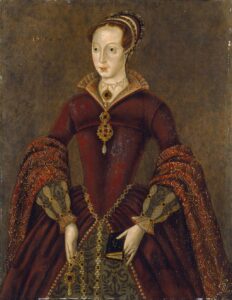
A Lady of Style, Education, and Grace
The date and location of Jane Grey’s birth are disputed among scholars and historians. By long-standing tradition, her birth occurred in October 1537 in Leicestershire, as the daughter of Henry Grey, Duke of Suffolk, and Frances Brandon. Early 21st-century scholarship disputes this tradition, placing her birth earlier, possibly as early as May 1536, in or near London, rather than in the country. Baptismal records are one of the tools available to historians to learn about the births of individuals in a time when they usually occurred at home. Infants were commonly baptized within days of their birth, a safeguard against their immortal souls being banned from heaven in case they were to succumb to one of the many hazards that threatened infants and their mothers in those more dangerous times.
Yet, there is no baptismal record for Jane Grey. British ecclesiastical law did not require the recording of baptisms in the church records until 1538, and Jane’s was evidently overlooked by whatever cleric performed the rite. To establish her time of birth, recent scholars have looked at the other end of Jane’s life, her execution on February 12, 1554, where documents declared her to be 17 years of age. Assuming those documents to be correct establishes her birth occurring before February 1537 though it does little to clarify the location. It will likely remain a subject of debate unless baptismal records one day do appear. After nearly five centuries, it seems unlikely.
At any rate, as the daughter of nobility, Jane received a liberal education. Her primary tutor was John Aylmer, an Anglican bishop and chaplain to her father. Aylmer tutored Jane in Greek, Latin, and Hebrew: the languages of the scriptures. From another tutor, Michelangelo Florio, she learned Italian. She preferred the study of languages and their corresponding cultures to more scientific studies, eschewing mathematics and astronomy. She also disdained the more physical activities expected of the nobility, including riding with hounds during the hunt and attending festivals and jousts popular among her peers. Tennis was a popular game among the nobility of 16th-century Britain, having been favored by Henry VIII. Lady Jane found it not to her taste. She preferred to quietly read Plato.
She also exhibited a resentment to discipline, referring to criticism by her parents of her behavior and decorum as harsh, claiming that she sometimes, “…think myself in hell”. She grew to resent being told how to sit, when to speak, when to remain silent, and the other rules of social decorum which dictated the proper behavior of the denizens of the court and noble houses. She preferred quiet periods of private correspondence in Greek and Latin to the socializing of receiving guests, dancing, and behaving as a courtier. She was withdrawn and frequently silent, encouraging her father to seek different living conditions for the young girl.
Becoming a Puppet of Power
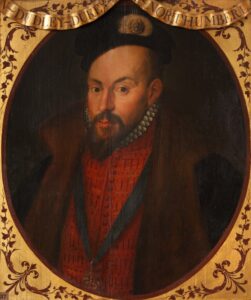
At the age of about ten, her father sent her to reside in the household of Thomas Seymour, Baron of Sudeley, where she attended Katherine Parr, the widow of Henry VIII. Seymour also happened to be the brother of Jane Seymour, who had been Henry’s third wife, and who had died of the complications of childbirth having borne the future King Edward VI in 1537.
Katherine Parr died in September 1548, also of complications of childbirth. At her funeral, Lady Jane Grey served as Chief Mourner. She was all of eleven years old.
Seymour’s machinations among the members of the Court were extraordinary, even in those times of intrigue and deception. He ingratiated himself with young King Edward, even while openly flirting with Edward’s half-sister, the future Elizabeth I. In the case of the latter, Seymour was known to visit Elizabeth in her private chambers, playfully tickling the teenage girl, while he was often clad in his own nightclothes. His brother, Edward Seymour, Duke of Somerset and Lord Protector to the young King Edward, viewed Thomas with suspicion. The Duke of Somerset joined with others suspicious of Thomas’s ambitions to eliminate his influence at court. Among the many charges which were eventually brought against Thomas was one that he had proposed the marriage of the King to Jane Grey.
Jane’s father instead countered with a proposed marriage of his daughter to Edward Seymour, Lord Hertford, son of the Lord Protector. Though nothing came of his suggestion, it did protect his daughter from the charges of treason which were eventually leveled against Thomas Seymour. The suggested marriage served to distance Lady Jane from Thomas Seymour by binding her, at least in the minds of courtiers, to Edward Seymour.
Thomas Seymour was arrested in January 1549 outside the King’s bedchamber at Hampton Court Palace, armed with a pistol. Some recountings of the incident state that he had shot one of the King’s beloved spaniels when the dog had the temerity to bark, sounding the alarm of an intruder near his master’s person. While discharging a pistol to silence a dog to prevent an alarm seems somewhat contradictory in logic, Seymour soon found his new residence to be in the Tower of London as a result of his actions.
He was unable to explain why he was near the King’s private rooms, in the middle of the night, while armed with a pistol. He was convicted without trial of high treason and executed in March 1549.
Jane managed to avoid charges, thanks to her father’s timely suggestion of marriage to Lord Hertford, though suspicion of her own ambitions remained among some members of the court. In May 1553, her engagement, arranged by her father and emissaries from her betrothed, was announced. She was engaged to Lord Guildford Dudley, the son of John Dudley, Duke of Northumberland, who served as Lord President of the Privy Council, making him for all intents and purposes the most powerful and influential man in all of England.
Lady Jane Grey and Lord Guildford Dudley were married on May 25, 1553. They were not the only bride and groom to stand before the altar at Durham House, London, that joyous day. Jane’s sister, Katherine Grey, wed Henry Herbert at the same ceremony. Lord Guildford’s sister, also named Katherine, married Henry Hastings alongside the other two happy couples. Thus, Jane Grey was denied the opportunity of being the center of the celebrations on her own wedding day, becoming instead just one of several enjoying being the center of attention and happiness.
The Path to the Throne
Lady Jane Grey had been married just six weeks when the King of England, Edward VI, died on July 6, 1553. The King had not yet reached his sixteenth birthday, making him younger than Jane, and during his brief reign, he had been largely at the mercy of his advisors. Unfortunately for the King, those advisors were ambitious men, covetous of personal power, and divided by religious beliefs and loyalties. Edward’s most powerful and influential advisor had been the Duke of Northumberland, a Protestant distrustful of all Catholics and their links to Rome and Spain. He was also, not coincidentally, Lady Jane Grey’s father-in-law at the time of Edward’s death.
Edward had been ill for some time, first complaining of the ailment which would claim his life in February 1553. Exactly what the disease was remains open to speculation. The attending surgeon who performed the post-mortem on the royal corpse determined His Majesty had succumbed to consumption, as tuberculosis was known at the time. Yet rumors of poisoning began almost immediately. Such rumors assigned responsibility for the crime to agents of Spain, agents of the Pope, supporters of a Catholic monarchy, and others. No evidence of poisoning emerged, but evidence was of little importance to extremists when possession of the throne was involved. Whisperings of poisonings and other connivances joined with legitimate charges throughout the Marian and Elizabethan reigns.
During the King’s illness, counselors led by Northumberland convinced His Majesty to alter his will, designating his rightful heir to the throne. By law, at the time Edward’s rightful heir was his half-sister, Mary, daughter of Henry VIII and Catherine of Aragon. Mary, as well as her sister Elizabeth, had been declared illegitimate after the marital and religious shenanigans of their father that had led to his marriage being annulled in 1533. In 1543, Parliament overturned that religious decision with the Third Succession Act. As Edward lingered near death, it was evident that Mary would succeed him to the throne, placing a Catholic at the head of the Church, as well as Head of State.
Edward, and perhaps, more importantly, Northumberland, opposed the idea of a Catholic Monarch, in part because of the potential influence of Catholic Spain on British affairs, and in part because they simply distrusted Catholicism. Northumberland convinced the dying Edward to issue a document forcefully expressing the Royal will regarding the succession. Edward’s document, called “My Devise for the Succession”, ignored the claims of his half-sisters Mary and Elizabeth and established a succession of male descendants only, of Frances Grey, Jane’s mother, or of Jane’s, or of her sisters.
Northumberland then persuaded the dying King to alter his original draft of the Devise. In doing so, Edward confirmed the illegitimacy of Mary and Elizabeth, as had been declared by their own father, Henry VIII. He extended the right of inheritance to women only in the absence of legitimate male heirs, and in so doing established Lady Jane Grey as the heir to the throne, followed by her sisters, in accordance with their ages. His “Devise” contravened the Third Succession Act, which would prove to be the demise of the “Devise”.
Accession as Queen
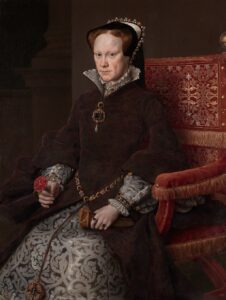
In 1544, Parliament had enacted the Third Succession Act. Though it did not re-establish the legitimacy of either Mary or Elizabeth Tudor, both daughters of Henry VIII, it did restore their positions in the line of succession, following their half-brother, Edward. According to the provisions of the Act, upon the death of Edward, Mary was the rightful heir to the throne. English law did not provide for the late King’s will circumventing, or overturning, a law enacted by Parliament. In this case, according to supporters of Parliament, the Divine Right of Kings was not above the law.
Edward had taken steps to ensure his Devise gained the force of law, including the writs prepared for the document to be taken up and passed by Parliament. He had obtained the support of numerous nobles, the influential Privy Council, and the bulk of officials which made up London’s government and political power, including bishops, other clergy, magistrates, bailiffs, and aldermen. Yet despite those efforts, at the time of his death the Devise remained merely a statement of his will, while the Act of Succession maintained the force of law.
Edward VI died on July 6, 1553. Northumberland and his supporters suppressed the news of the King’s demise, knowing that Mary Tudor, then at Hunsdon, near the Welsh border, would act on her own claim to the throne. On July 9, Lady Jane Grey was informed that by the will of the late King, she had ascended to the throne. According to all sources, she accepted the judgment of the late Edward hesitatingly, expressing her reluctance to become Queen. On July 10, after she had been secured in the safety of the Tower of London, the Privy Council, under the urging of Northumberland, declared her Queen of England, Ireland, and France, all titles under which Edward VI had been styled.
At the time, residence in the Tower by the Monarch awaiting coronation was the accepted custom. While Jane remained there, Northumberland took steps to arrest Mary Tudor before she gained substantial support for her claim as rightful Queen, consolidating his own authority and control over the realm. When he became aware of Mary’s having moved to East Anglia, he set out to arrest her, departing London with a small body of troops on July 14.
On July 19, the Privy Council reversed its position and declared Mary Queen. Exactly why the council changed its position remains unclear, though significant evidence exists that a coup was engineered and executed by the Earl of Arundel, Henry FitzAlan, a long-time enemy of Northumberland, a Catholic, and a supporter of Mary. With the announcement of Mary as Queen, Jane Grey became a pretender, an enemy to the monarchy, and thus by extension, guilty of treason. Overnight she went from being the Queen of England, residing in the Tower while awaiting coronation, to a prisoner in the Tower, accused of treason against the Queen.
Trial for Treason
On July 19, 1553, both Jane and her husband, Guildford, were imprisoned in the Tower, she in the Gaoler’s apartments, and he in other, less accommodating rooms. The following day, Northumberland acquiesced to the will of the Privy Council and pronounced his support of Mary as Queen. Nonetheless, he was arrested and taken to the Tower, where he was held until his trial in August. He attempted to assuage Mary’s anger towards him by claiming he had returned to Catholicism, but to no avail. He was executed by beheading on August 22.
Having disposed of Northumberland, the attention of the court turned to Lady Jane and Guildford. Jane was referred to in the courts simply as Jane Dudley, stripped of her honorifics and titles. She remained in the Tower, isolated from her husband, a girl still in her teens no doubt bewildered by the turn of events that had reduced her to her situation. The former Archbishop of Canterbury, Thomas Cranmer, who had committed the crime of announcing his loyalty to his Queen when she was so-named by the Privy Council, was charged alongside her. So was her husband. Cranmer managed to elude punishment as a result of his association with Lady Jane, though he was eventually convicted of heresy and burned at the stake in 1556. It was a harsh age.
Guildford and Lady Jane were tried in November, 1553, before a special commission assembled for the purpose in London. Their guilt was predetermined and accordingly announced after a brief trial. Jane was sentenced to death, either by beheading or by being burned at the stake, the preferred punishment for treasonous women at the time. The choice of which punishment was to be selected was left to the discretion of Queen Mary. There were appeals to the Queen to show mercy to Lady Jane, and for several weeks following her conviction, she remained a prisoner in the Tower, with no date for her execution scheduled.
It appears that the evidence against Lady Jane Grey was insubstantial, with the exception of a few documents to which she had affixed her signature during her brief nine-day reign. These showed her signing her name as “Jane the Quene”. Whether the signature was actually hers remains unknown, but to the commission of her accusers who tried her they established she had attempted to exercise the power of the Monarch, usurped the title, and in so doing committed treason against the rightful Queen. In effect, she signed her own death warrant.
Wyatt’s Rebellion
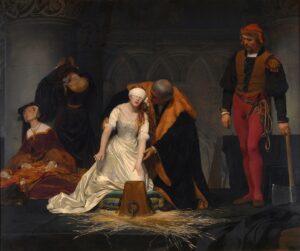
In January 1554 the announcement of Queen Mary’s engagement to King Philip of Spain raised significant opposition in England from British Protestants. The idea of a Catholic Queen of England marrying a Catholic King of Spain was a fearful one to those who professed Protestant beliefs. Thomas Wyatt, an English political figure, was himself a Catholic and supporter of Queen Mary, but had witnessed Spanish persecutions of “infidels” during the Inquisition and feared their spreading into Britain. He led a revolt against the proposed union of Mary and Philip.
There is little if any evidence that Wyatt supported the restoration of Lady Jane to the throne, but hard evidence was not a requirement of those who wished Lady Jane eliminated. In addition, Jane’s father, Henry Grey, Duke of Suffolk, joined in the rebellion led by Wyatt. Though Wyatt formed a substantial military force and demanded the Tower be surrendered to him, the rebellion was quashed with minimal bloodshed. Wyatt himself surrendered to the Queen’s forces after the Queen offered pardons to most of his followers. Wyatt was tried for treason in March 1554. During his trial, mercy was offered should he offer evidence that implicated Mary’s sister, the future Queen Elizabeth. To the followers of Queen Mary, no one was above suspicion. Either Wyatt had no such evidence or he remained loyal to Elizabeth; she was not charged, though she was held under house arrest for several months.
Wyatt’s association with Henry Grey was noted, however, and despite the absence of anything pointing to the involvement of Lady Jane Grey, her enemies raised the issue that her continued existence represented a threat to Mary’s reign. Mary agreed that Jane had to be eliminated since her presence served as a potential rallying symbol for Protestant enemies of her reign.
On February 9, 1554, while Wyatt’s Rebellion remained unresolved, Queen Mary offered Lady Jane Grey a brief stay of execution, giving her three days to examine her mortal soul and convert to Catholicism. She dispatched her personal confessor, John Feckenham, to oversee the conversion. Jane refused the opportunity to be baptized as a Catholic, though she requested that the Catholic priest accompany her to the scaffold on the day of her execution.
On February 12, 1554, Guildford Dudley was taken from his rooms in the Tower to the place of public execution located on Tower Hill. There he was beheaded. His body was conveyed back to the Tower, passing the rooms occupied by Jane, who saw it as it was trundled by without ceremony in a horse-drawn cart.
The young widow was then escorted to Tower Green, located inside the fortress. Jane was allowed to give a brief speech to witnesses, and she did so along with reciting Psalm 51, including the words, “…Have mercy upon me, O God, according to thy loving kindness…” She then tied her own blindfold, before attempting to find the chopping block upon which to lay her head. Unable to see, she cried out in frustration, “Where is it?” Aided to the block, she then spoke a last time, quoting the dying words of Jesus, according to Matthew, “…into thy hands I commend my spirit”. According to witnesses, her head was severed by a single stroke.
Legacy
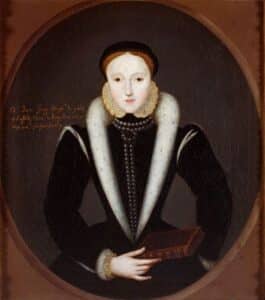
Jane and Guildford Dudley were buried near Tower Green, their grave unmarked by a memorial or stone. Less than two weeks after her execution, Jane’s father met the same fate, for his part in the ill-fated Wyatt’s Rebellion. According to legend, his mummified head was discovered in a London churchyard in the 1850s. Whether or not the head was actually that of the father of Lady Jane Grey has never been definitively determined, and it is today buried at St Botolph’s Church, Aldgate, London.
Lady Jane Grey came to be viewed as a Protestant martyr, another victim of the purges carried out during the reign of Queen Mary I, known to posterity as Bloody Mary. The young Lady Jane came to be viewed, by subsequent generations of British Protestants, as a courageous, albeit tragic, heroine. She was celebrated in literature, song, poetry, and art as innocent, heroic, scholarly, and pure. She became, in legend, peerless in her beauty, her accomplishments, her loyalty to her husband, and in her obligations to her country and her faith.
In truth, Lady Jane Grey, though clearly well-educated and accomplished, was more a victim than anything else. She was used by thoroughly ambitious, manipulative, and unscrupulous men to advance their careers and goals with little regard for her well-being. She did not reach the age of eighteen, meaning that by modern standards she never advanced beyond childhood. Yet, her legacy has endured for centuries.
Protestant faiths still hold her in esteem as a martyr, though she died not for her refusal to deny her beliefs, but rather for the treasonous behavior of those who used her to advance their own causes. In many ways, she is still the unwitting symbol of those who would use her for their purposes, uncaring of how it affects her own reputation, and unwilling to allow her to follow her own destiny. A brief life beset with tragedy, and an enduring reputation as what others have chosen her to be. Such is the true legacy of Lady Jane Grey.



